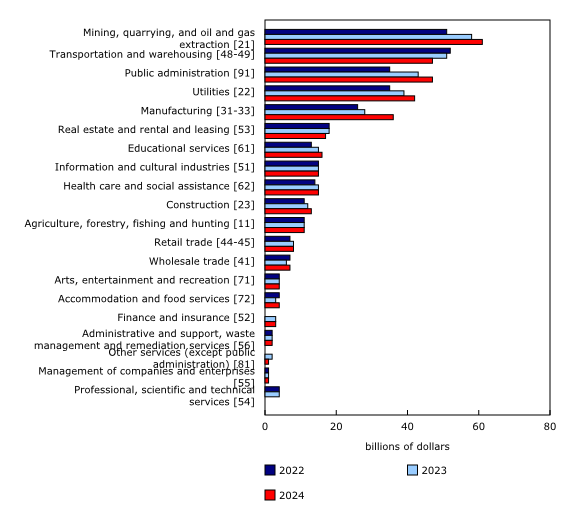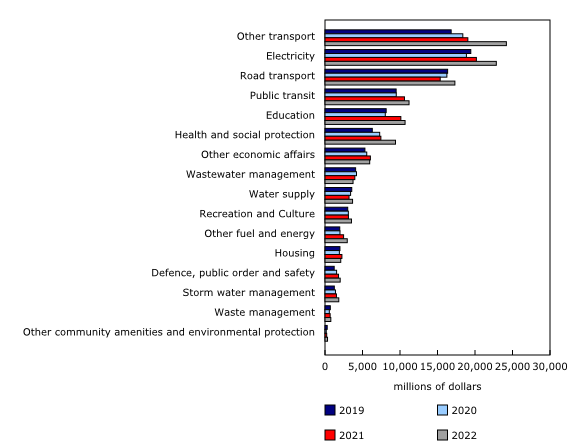Non-residential capital and repair expenditures, 2022 (revised), 2023 (preliminary) and 2024 (intentions)
Released: 2024-02-27
Total capital expenditures by businesses and governments on non-residential tangible capital assets are expected to increase by 4.5% to $353.9 billion in 2024. This represents a fourth consecutive annual increase. Growth in the private sector (+4.8%) and the public sector (+3.9%) is expected in 2024.
Capital spending in mining, quarrying, and oil and gas extraction to top $60 billion in 2024
Capital expenditure growth in the mining, quarrying, and oil and gas extraction sector is expected to continue this year (+4.8% to $61.0 billion), following two years of growth (+13.9% in 2023 and +36.3% in 2022).
In 2024, a 2.7% decrease in capital outlays at mines and quarries, mostly related to the completion of new gold mines in Ontario, would partially offset the $3.2 billion (+8.2%) growth anticipated in the oil and gas extraction subsector.
In 2024, Saskatchewan should lead the sector's growth, with capital outlays rising $1.7 billion (+22.5%), following a 53.1% increase in 2023, as the province benefits from large investments in the mining and quarrying (except oil and gas) subsector and the oil and gas extraction subsector. British Columbia (+$1.4 billion) and Alberta (+$1.2 billion) should follow closely, with additional capital outlays planned for 2024 mostly related to increased activity in oil and gas extraction.
Manufacturing industries to invest more in 2024
Capital outlays in the manufacturing sector are expected to increase by 31.0% in 2024 to $36.2 billion, up from $27.7 billion in 2023.
There have been several major project announcements supported by multiple federal and provincial government programs to incentivize developments in decarbonization and clean energy. The Canada Energy Regulator announced the construction of seven new renewable diesel facilities in Canada following the implementation of the federal government's 2020 Clean Fuel Regulations. In January 2024, Ontario announced that it had attracted $27 billion in new investments in the past three years related to motor vehicle and electric vehicle manufacturers and suppliers. Quebec and British Columbia have also announced major investments in the battery supply chain.
In addition, a major chemical manufacturer recently announced an investment of more than $11.5 billion in a net-zero emissions ethylene facility, while an industrial gas manufacturer announced a new $1.6 billion net-zero emissions hydrogen energy complex.
Investments in the chemical manufacturing subsector are expected to bounce back in 2024 (+73.2%) to $5.3 billion after a decline in 2023 (-25.9%), as major projects approached completion. Similarly, a 100.4% increase is anticipated in the transportation equipment manufacturing subsector after an 18.0% decrease in 2023 related to the timing of major projects.
Of the 21 manufacturing subsectors, 5 anticipate a decrease in capital investments in 2024: wood product manufacturing (-14.2%), paper manufacturing (-2.3%), printing and related support activities (-11.0%), petroleum and coal product manufacturing (-0.6%) and apparel manufacturing (-10.4%). For comparison, seven manufacturing subsectors recorded declines in 2023.
Sustained growth in the public sector
If intentions are realized, public sector organizations would invest $131.8 billion in 2024, following seven years of consecutive growth. The public administration sector would increase capital expenditures to $47.1 billion in 2024 (+8.6%), following a 22.9% growth in 2023.
The utilities sector is the second-largest contributor to the anticipated growth in public investments in 2024, with a $3.2 billion increase (+11.7%) to $30.6 billion. Additionally, private businesses in utilities anticipate a 4.0% increase in capital spending to $11.8 billion in 2024. Ontario and Quebec are expected to account for 82.9% of the increased capital expenditures in 2024 for this sector. Major refurbishments and small modular reactor projects continue at nuclear generating stations in Ontario. Meanwhile, Hydro-Québec announced plans to almost double its investments in network sustainability by 2035 to reduce power outages by 35% and to invest at least $90 billion in the addition of 8,000 to 9,000 megawatts of capacity and 5,000 kilometres of transmission lines.
Capital expenditures in the health care and social assistance sector are expected to increase by 3.0% in 2024 to $15.4 billion, following increases of 10.3% in 2023 and 23.8% in 2022. While public sector organizations account for most of those investments, the private sector plans to increase capital expenditures in the sector by 6.8% to $2.5 billion in 2024. Budget 2023 committed to investing more than $200 billion over 10 years to support the Working Together to Improve Health Care for Canadians Plan. On February 15, 2024, seven provinces and territories had signed bilateral agreements with the federal government. In addition, following the announcement in Budget 2021 of $27 billion over five years for a Canada-wide early learning and childcare system, six provinces and territories signed onto the program and implemented $10-a-day-or-less childcare. The remaining provinces and territories had reduced costs by at least 50% by December 2023. The program aims to support the creation of 250,000 new childcare spaces by March 2026.
Capital expenditures on Canadian infrastructure increase by 13.4% in 2022
Today's release includes capital expenditures incurred in 2022 by type of asset, as well as investments in Canadian infrastructure according to their function.
Total capital spending on infrastructure assets, including on social and affordable rental housing, increased by 13.4%, or $14.5 billion, to $122.6 billion in 2022. Growth was observed for 13 of the 16 infrastructure functions. The other transport (air, rail, water and pipeline) (+$5.1 billion) and electricity (+$2.7 billion) functions were the largest contributors to this growth, as major construction projects in pipeline transportation and in the electric power grid continued during the year. Spending increased on both privately owned (+18.5%) and publicly owned (+11.8%) infrastructure assets in 2022.
Investments in health and social protection rose by 26.2%, or $2.0 billion, with increased spending occurring in all provinces and territories except the Northwest Territories. Capital expenditures on infrastructure decreased in Nunavut (-32.6%), Newfoundland and Labrador (-30.6%) and Manitoba (-1.4%) in 2022. The completion of major electricity projects was mainly responsible for the declines in Newfoundland and Labrador and in Manitoba.
Capital expenditures on infrastructure assets were largest in either the road transport function or the electricity function in seven provinces and one territory. However, the other transport function exceeded all others in British Columbia ($12.7 billion) and Alberta ($7.5 billion), largely because of major pipeline projects. In Newfoundland and Labrador, health and social protection received the largest share of infrastructure spending by function ($391.5 million). In the Northwest Territories, the other community amenities and environmental protection function was the largest in terms of investments, as major projects to remediate abandoned mine sites were underway.
Did you know we have a mobile app?
Get timely access to data right at your fingertips by downloading the StatsCAN app, available for free on the App Store and on Google Play.
Note to readers
The Capital and Repair Expenditures Survey is based on a sample survey of 27,000 businesses, governments and institutions. The survey on preliminary estimates for 2023 and intentions for 2024 was conducted from September 2023 to January 2024.
Data in this release are expressed in current dollars.
The public sector includes governments and enterprises for which the government has effective control or at least 50% of voting rights.
Infrastructure is the physical structures and systems that support the production of goods and services and their delivery to and consumption by governments, businesses and citizens. The product "Sources and Methods: Capital Investment in Infrastructure" provides a summary of concepts and comparability with alternative data sources.
Visit the Construction statistics and Infrastructure statistics portals to find data, publications and interactive tools related to construction or infrastructure statistics in one convenient location.
Real time data tables
Real time data tables 34-10-0278-01 and 34-10-0279-01 will be updated March 1, 2024.
Contact information
For more information, or to enquire about the concepts, methods or data quality of this release, contact us (toll-free 1-800-263-1136; 514-283-8300; infostats@statcan.gc.ca) or Media Relations (statcan.mediahotline-ligneinfomedias.statcan@statcan.gc.ca).
- Date modified:




